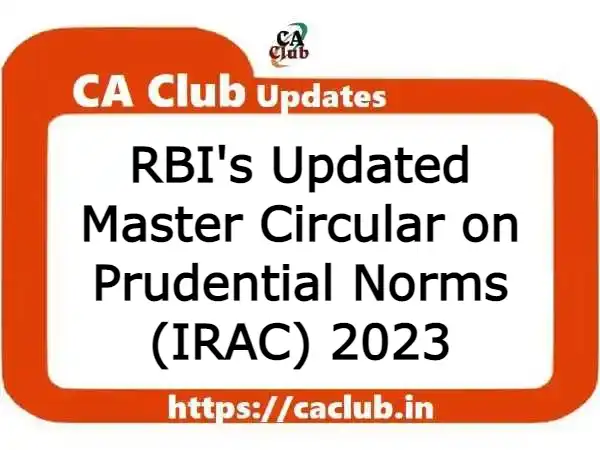The Reserve Bank of India (RBI) has recently issued a revised Master Circular on Prudential Norms for Income Recognition, Asset Classification (IRAC), and Provisioning pertaining to Advances. This article will provide an overview of the key aspects of this circular, and explain its implications for banks operating in India.
RBI Master Circular dated 01/04/2023: Prudential norms on Income Recognition, Asset Classification (IRAC) and Provisioning pertaining to Advances (consolidated upto 31/03/2023)
Overview of the RBI Master Circular
The updated Master Circular, dated 01/04/2023, consolidates the RBI guidelines, directions, instructions, and revisions related to Prudential Norms for income recognition, asset classification, and provisioning up to 31/03/2023. The aim of these norms is to enhance consistency and transparency in the published accounts of banks’ advances portfolios.
Objective Income Recognition Policy
According to the Prudential Norms, income recognition policies should be based on objective criteria that ensure income is recognized according to the record of recovery, rather than subjective considerations. Banks are prohibited from charging or debiting interest in any non-performing asset (NPA) account, including government-guaranteed accounts, for income recognition purposes.
However, interest on advances against term deposits, National Savings Certificates (NSC), Indira Vikas Patra (IVP), Kisan Vikas Patra (KVP), and life insurance policies may be recognized on the due date without realization, as long as adequate margin is available.
Asset Classification Categories
The Prudential Norms require banks to classify non-performing assets into three categories:
i) Sub-standard;
ii) Doubtful; and
iii) Loss Assets.
The classification is based on the period for which the asset has remained non-performing and/or the dues have remained unrealized. Banks must conduct the classification exercise using objective criteria to ensure uniform and consistent application of the Prudential Norms.
Responsibilities of Bank Management and Statutory Auditors
Both the bank management and statutory auditors share responsibility for ensuring that adequate provisioning has been made in compliance with the Prudential Norms. The provisioning should be based on the age of assets classified as NPA and the realizable value of the available security under respective accounts.
By adhering to the updated Master Circular on Prudential Norms, banks can maintain greater consistency and transparency in their financial reporting, which will ultimately contribute to a more stable and robust banking system in India.
FAQs
1. What are some specific examples of acceptable collateral for interest recognition on advances without realization, as long as adequate margin is available?
Some specific examples of acceptable collateral for interest recognition on advances without realization, as long as adequate margin is available, include term deposits, National Savings Certificates (NSC), Indira Vikas Patra (IVP), Kisan Vikas Patra (KVP), and life insurance policies.
2. How do the Prudential Norms contribute to improving the overall stability and robustness of the Indian banking system?
The Prudential Norms contribute to improving the overall stability and robustness of the Indian banking system by promoting consistency and transparency in the published accounts of banks’ advances portfolios. By ensuring that income recognition, asset classification, and provisioning are based on objective criteria, the norms help to provide an accurate representation of the financial health of banks, which ultimately supports a more stable banking environment.
3. Are there any penalties or consequences for banks that do not adhere to the updated Master Circular on Prudential Norms?
While there is explicit mention of penalties or consequences for non-compliance with the updated Master Circular on Prudential Norms, it is likely that banks that fail to adhere to these norms may face regulatory sanctions, fines, or other penalties from the Reserve Bank of India (RBI) under different provisions of the Banking Regulation Act, 1949.
4. What is the role of the Reserve Bank of India in ensuring that banks follow the Prudential Norms for income recognition, asset classification, and provisioning?
The role of the Reserve Bank of India in ensuring that banks follow the Prudential Norms for income recognition, asset classification, and provisioning involves issuing guidelines, directions, instructions, and revisions related to these norms, as well as monitoring compliance and potentially imposing penalties on banks that do not adhere to the norms.
5. How do the updated Prudential Norms address the issue of subjectivity in income recognition policies, and how does this impact the accuracy of banks’ financial reporting?
The updated Prudential Norms address the issue of subjectivity in income recognition policies by requiring that income recognition be based on objective criteria that ensure income is recognized according to the record of recovery, rather than subjective considerations. This approach helps to increase the accuracy of banks’ financial reporting by ensuring that income is recognized only when there is a reliable indication of repayment, rather than being influenced by subjective factors that may not accurately reflect the likelihood of recovery.
Related Posts:
RBI’s Updated Master Circular 2024 on Prudential (IRAC) Norms for Loans & Advances
Annexure 5 on List of Circulars consolidated by the RBI’s Master Circular on IRAC Norms dt. 01/04/2023 has information on about 104 items (i.e. reference to Circulars issued during 1994 to 2022). I have a question that when RBI has last consolidated the Circular in 2023, then why the old circulars (i.e. prior to 01/04/2023) are being repeated? In case I have misunderstood then it is requested to kindly enlighten me. Thanks.
If it is stated that it consolidates the circular up to 2022-23 then we come across a new question, what about the past circulars. So all the circulars are mentioned, which is important.